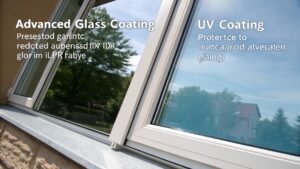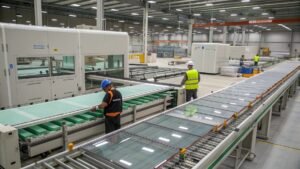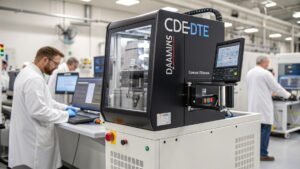Solar panels lose 4-8% efficiency due to surface reflection and soiling. These losses cost thousands in reduced energy production over a panel’s lifetime.
Anti-reflective glass coatings increase solar panel efficiency by 2.5-4% through reduced surface reflection, achieving light transmittance above 96%. Hydrophilic self-cleaning coatings maintain peak performance by preventing dust accumulation, while specialized coatings for perovskite and thin-film technologies enable next-generation solar cell development.
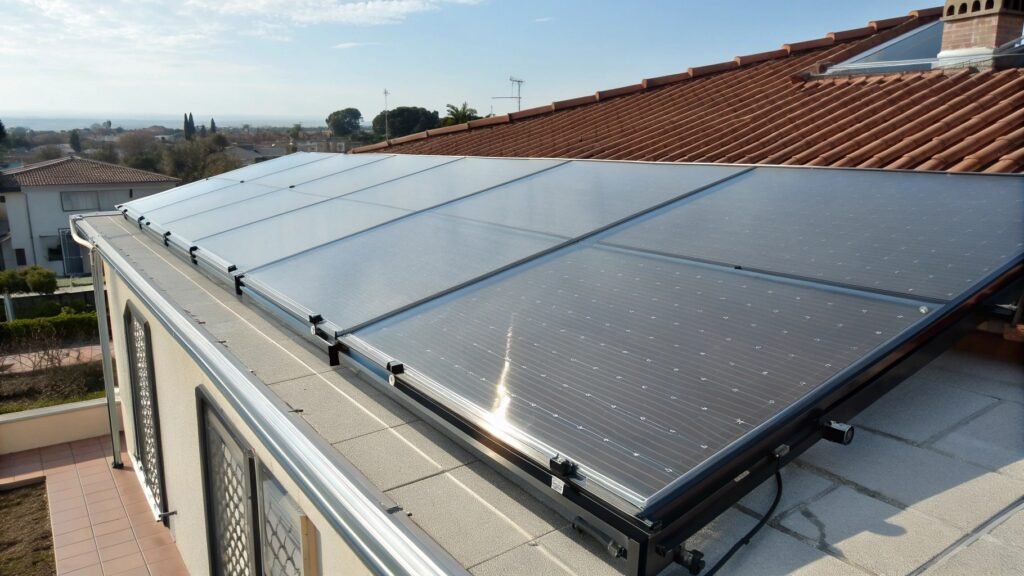
![]()
During my decade of experience in glass coating technology, I have witnessed how proper surface treatments transform solar panel performance. Many manufacturers focus solely on cell efficiency while overlooking the glass cover that determines how much light reaches the active layer. The right coating technology can recover efficiency losses that would otherwise require expensive cell upgrades.
What anti-reflective coatings deliver maximum light transmission gains?
Anti-reflective coatings eliminate the 8% reflection loss that occurs at uncoated glass surfaces. This improvement directly translates to increased power output from solar panels.
Anti-reflective coatings using single-layer magnesium fluoride or dual-layer silicon oxide/titanium dioxide systems achieve light transmittance of 94.6-96.5%. These coatings increase solar panel power output by 2.5-4% while maintaining durability for 25+ year warranties through proper material selection and application processes.
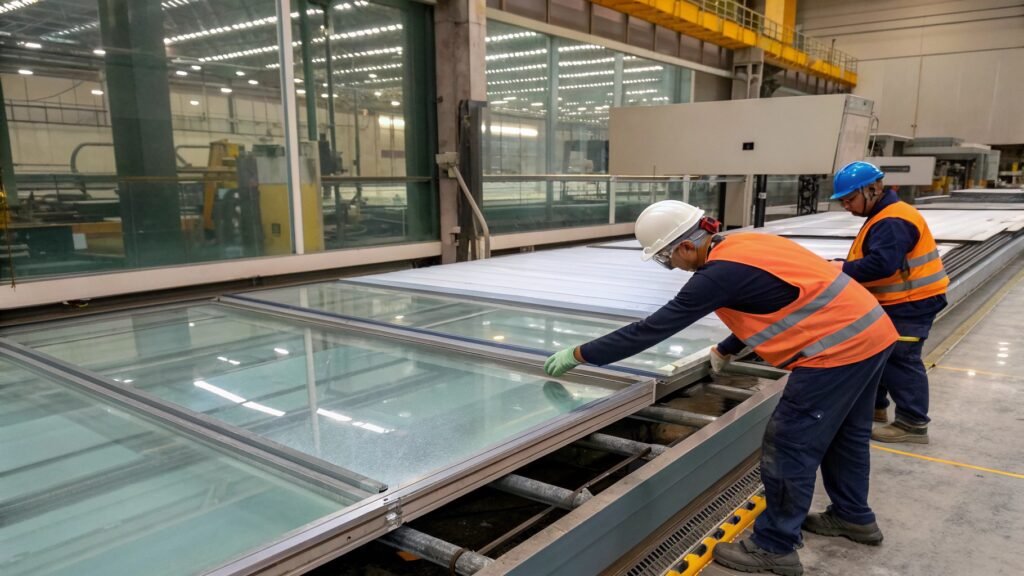
Our photovoltaic glass anti-reflective coating line1 applies these advanced coatings with precise thickness control across glass panels up to 2.4 meters. The wet coating process creates more durable bonds compared to vacuum-deposited films while enabling cost-effective high-volume production.
Single-layer AR coatings use materials with refractive indices between glass and air. Magnesium fluoride provides excellent performance for crystalline silicon panels with refractive index of 1.38. The optimal thickness equals one-quarter wavelength of the peak solar spectrum around 550nm.
Dual-layer systems achieve broader spectral performance by combining high and low refractive index materials. Silicon dioxide base layers with titanium dioxide or tantalum pentoxide top layers create interference effects that minimize reflection across wider wavelength ranges.
Coating uniformity becomes critical for consistent panel performance. Thickness variations create visual patterns and performance differences across the panel surface. Our equipment maintains coating thickness within ±3% across full-size solar glass panels through precision flow control and environmental management.
Process temperature affects both coating quality and glass thermal stress. Lower temperatures reduce stress but require longer curing times. Higher temperatures accelerate processing but can cause bow in large glass panels. Optimal processing balances throughput with quality requirements.
| Coating System | Layers | Peak Transmittance | Efficiency Gain | Durability |
|---|---|---|---|---|
| MgF2 Single | 1 | 94.6% | 2.5% | 20+ years |
| SiO2/TiO2 Dual | 2 | 96.2% | 3.8% | 25+ years |
| Advanced Multi | 3+ | 96.8% | 4.2% | 25+ years |
| Broadband AR | 2-3 | 95.8% | 3.5% | 25+ years |
How do self-cleaning coatings maintain panel performance over time?
Dust and soiling can reduce solar panel output by 15-25% in dusty environments. Self-cleaning coatings prevent this performance degradation through photocatalytic and hydrophilic surface properties.
Self-cleaning glass coatings using titanium dioxide nanoparticles create hydrophilic surfaces that sheet water evenly across the glass. Combined with photocatalytic properties that break down organic contaminants, these coatings maintain 95%+ of peak performance in outdoor environments while reducing cleaning maintenance by 70%.
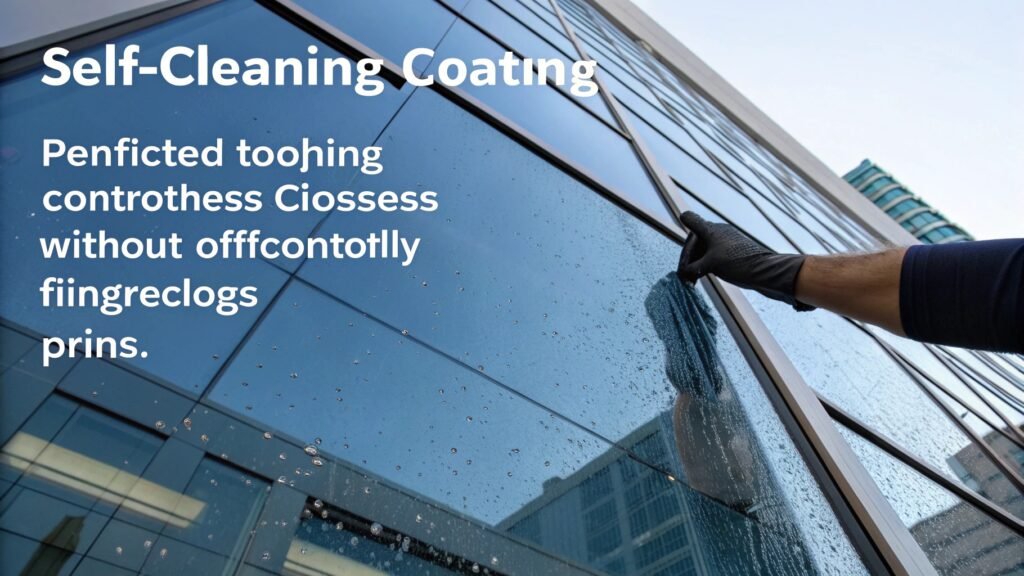
Photocatalytic coatings use UV energy from sunlight to activate chemical reactions that decompose organic pollutants. Titanium dioxide particles absorb UV radiation and generate reactive oxygen species that break down dirt, oils, and biological contaminants on the glass surface.
Hydrophilic surface properties cause water to spread uniformly rather than forming droplets. This sheeting action carries away loosened contaminants during rain or cleaning operations. The combination of photocatalytic decomposition and hydrophilic washing provides continuous self-cleaning action.
Coating durability requires proper material selection and application methods. Anatase crystal form titanium dioxide2 provides superior photocatalytic activity compared to rutile forms. However, anatase transforms to rutile at high temperatures, so processing conditions must maintain crystal structure integrity.
Field testing demonstrates significant maintenance reduction benefits. Solar installations with self-cleaning coatings maintain higher average power output and require 50-70% fewer cleaning cycles. The labor cost savings often justify the coating investment within 3-5 years.
Integration with anti-reflective properties creates dual-function coatings that both increase light transmission and maintain surface cleanliness. These systems require careful optimization to achieve both optical and self-cleaning performance without compromising either function.
| Environment Type | Soiling Rate | Cleaning Frequency | Performance Retention |
|---|---|---|---|
| Urban/Industrial | High | Monthly | 85-90% |
| Rural/Agricultural | Medium | Quarterly | 90-95% |
| Desert/Arid | Very High | Bi-weekly | 75-85% |
| Coastal/Marine | Low-Medium | Semi-annual | 92-97% |
Which coating technologies enable next-generation perovskite solar cells?
Perovskite solar cells require specialized coating processes for the active layer deposition and protective encapsulation. These emerging technologies promise higher efficiencies at lower costs.
Perovskite solar cell coatings require precise thickness control within ±5% uniformity, controlled atmosphere processing, and low-temperature annealing below 150°C. Advanced coating systems handle perovskite solutions with slot-die heads, maintain moisture levels below 10ppm, and integrate with annealing systems for continuous production of high-efficiency cells.
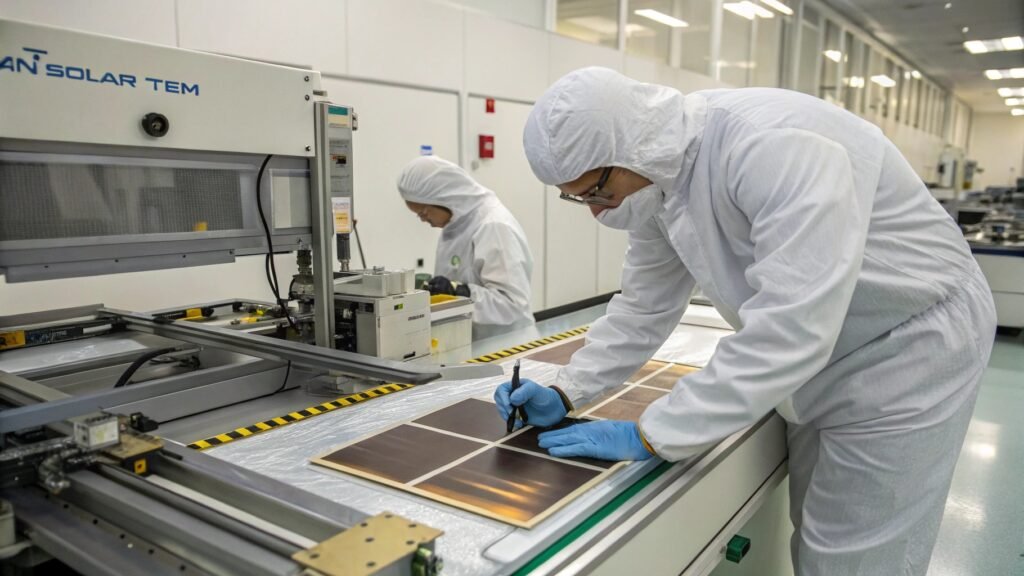
Our perovskite material coating and annealing line addresses the unique challenges of these next-generation solar technologies. Perovskite materials are moisture-sensitive and require inert atmosphere processing throughout the coating and curing sequence.
Slot-die coating heads3 provide superior thickness uniformity compared to spin coating methods used in laboratory research. The continuous coating process enables large-area panel production while maintaining the precise thickness control required for optimal device performance.
Solvent management becomes critical for perovskite solution stability. DMF, DMSO, and other solvents used in perovskite precursor solutions require controlled evaporation rates to achieve proper crystallization. Too-rapid drying creates pinhole defects while slow drying allows crystal growth that reduces uniformity.
Annealing temperature and atmosphere control determine final perovskite crystal structure and device performance. Most perovskite formulations require annealing between 100-150°C in nitrogen atmosphere. Temperature uniformity across large panels must maintain ±2°C to prevent performance variations.
Quality control monitoring tracks solution concentration, coating thickness, and crystalline structure in real-time. Spectroscopic analysis verifies proper perovskite formation while optical measurement confirms thickness uniformity across the entire panel area.
How do specialized coatings optimize thin-film solar technologies?
Thin-film solar technologies including CdTe, CIGS, and amorphous silicon require specific coating processes for both active layer deposition and performance enhancement. Each technology has unique processing requirements.
Thin-film solar coating technologies use precision spray systems for CdCl2 activation treatments, sputtering processes for transparent conducting layers, and chemical bath deposition for buffer layers. These processes achieve efficiency improvements of 15-25% over baseline devices through optimized interface properties and enhanced light management.
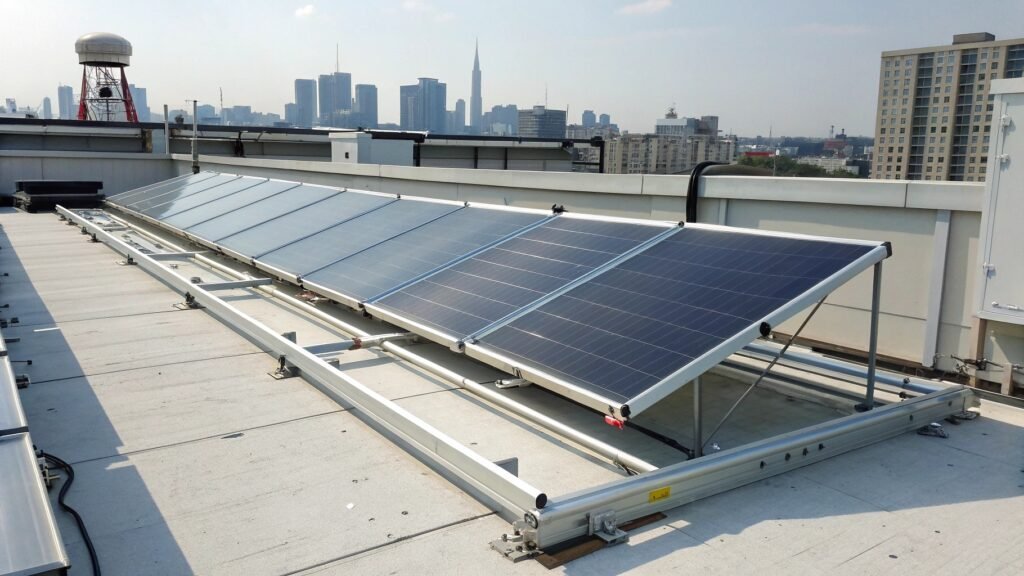
CdTe solar cell production requires precise CdCl2 treatment4 to activate the absorber layer and improve grain structure. Our thin-film CdTe PV technology line applies this critical treatment with micro-spray systems that achieve uniform coverage across large-format panels up to 1220x2440mm.
The CdCl2 activation process requires precise solution concentration, application temperature, and subsequent annealing conditions. Too little activation reduces efficiency while excess CdCl2 can cause device instability. Process monitoring tracks these parameters to maintain optimal performance.
Transparent conducting oxide layers require specific optical and electrical properties. High transparency in visible wavelengths combined with low sheet resistance enables efficient current collection. Fluorine-doped tin oxide and aluminum-doped zinc oxide are common materials requiring different processing approaches.
Buffer layer deposition between the window layer and absorber affects device efficiency and stability. Chemical bath deposition of cadmium sulfide provides excellent interface properties but requires precise pH, temperature, and concentration control throughout the process.
Back contact optimization improves carrier collection and device performance. Specialized coating processes create ohmic contacts with low series resistance while maintaining mechanical stability throughout thermal cycling.
| Technology | Key Coating | Process Temperature | Efficiency Impact | Uniformity Requirement |
|---|---|---|---|---|
| CdTe | CdCl2 Treatment | 400-450°C | +2-3% absolute | ±5% |
| CIGS | Mo Back Contact | 300-500°C | +1-2% absolute | ±3% |
| a-Si | TCO Window | 200-300°C | +1.5% absolute | ±2% |
| Perovskite | Active Layer | 100-150°C | +5-8% absolute | ±5% |
What quality control measures ensure consistent solar coating performance?
Solar panel coatings must maintain performance for 25+ year warranties. Comprehensive quality control prevents field failures that would compromise energy production and manufacturer reputation.
Solar coating quality control includes spectral transmission measurement across 300-1200nm wavelengths, adhesion testing to 4H hardness standards, accelerated weathering simulation, and real-time process monitoring. These measures achieve coating performance retention above 98% after 25-year equivalent testing while maintaining thickness uniformity within ±3% across meter-scale panels.
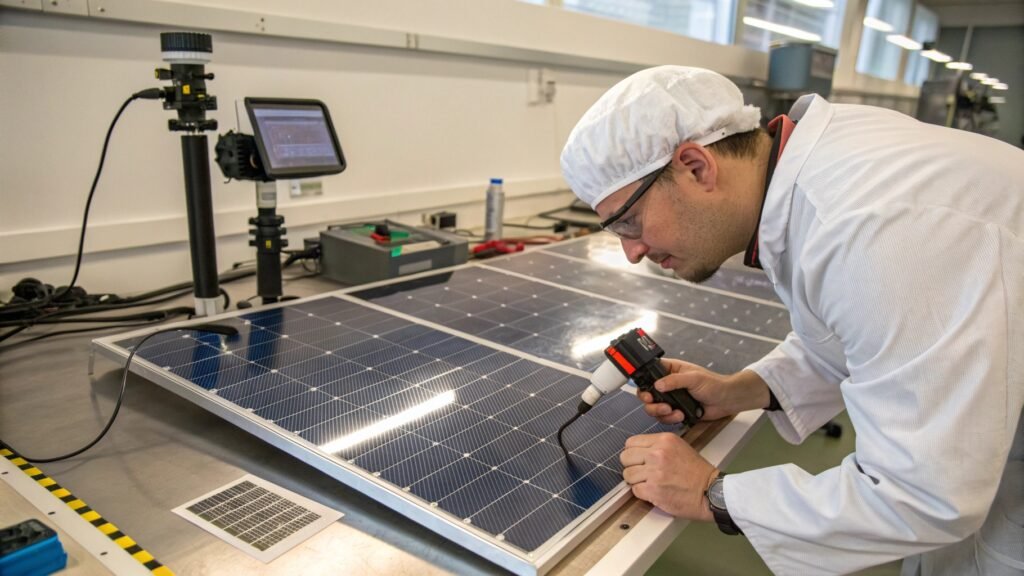
Spectral measurement verifies optical properties across the solar spectrum from UV through near-infrared wavelengths. Laboratory spectrophotometers measure transmission and reflection with 1nm resolution to confirm coating performance meets design specifications. This data validates both anti-reflective effectiveness and spectral selectivity.
Environmental testing subjects coatings to accelerated aging conditions including UV exposure, thermal cycling, humidity changes, and mechanical stress. These tests simulate 25+ years of outdoor exposure in weeks of laboratory time. Coatings must maintain optical properties and adhesion throughout accelerated testing.
Process monitoring tracks critical parameters including coating thickness, cure temperature, ambient humidity, and solution concentration. Statistical process control identifies trends that might affect coating quality before they produce defective panels. Real-time feedback enables immediate process corrections.
Adhesion testing ensures coatings survive thermal expansion, wind loads, and hail impact throughout the panel lifetime. Cross-cut tests, pull-off measurements, and thermal shock testing verify coating durability under various stress conditions.
Optical coherence tomography provides non-destructive thickness measurement across entire panel surfaces. This advanced measurement technique identifies thickness variations that could affect performance uniformity or create visual defects in finished panels.
| Test Parameter | Measurement Range | Acceptance Criteria | Test Frequency |
|---|---|---|---|
| Transmittance | 300-1200nm | >94% at 550nm | Every panel |
| Thickness | 50-200nm | Target ±10% | 10 points per panel |
| Adhesion | 0-5H hardness | Minimum 3H | 1 per 100 panels |
| Uniformity | Full panel area | ±3% variation | Every panel |
How does coating integration affect overall solar module assembly?
Coating processes must integrate seamlessly with solar module assembly lines to maintain production efficiency while delivering performance benefits. Process compatibility prevents bottlenecks and quality issues.
Solar coating integration requires coordinating with cell lamination schedules, maintaining coating cleanliness through assembly, and optimizing cure cycles for continuous production. Proper integration maintains line speeds above 1200 panels per day while ensuring coating performance throughout the 25+ year module lifetime.
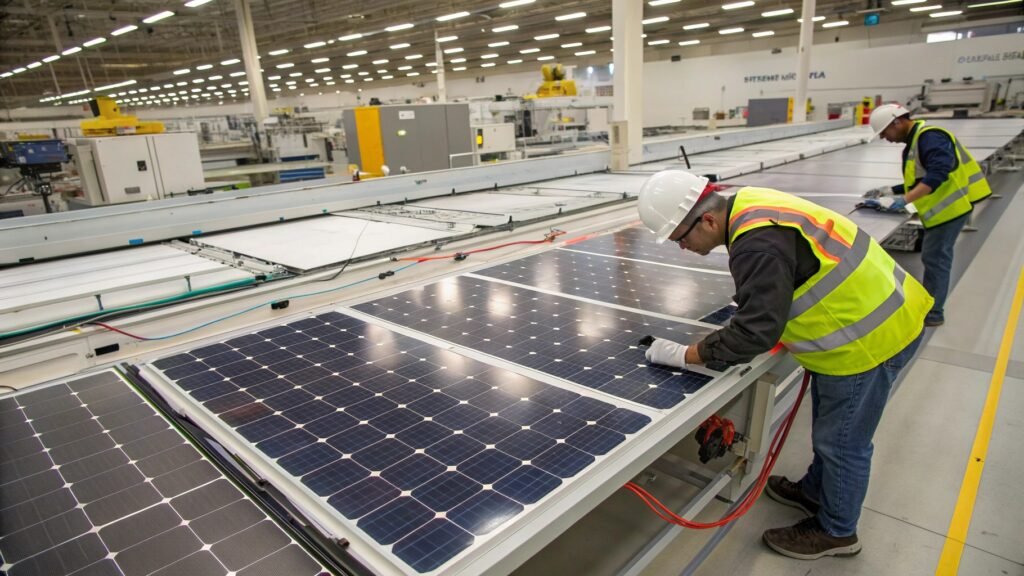
Coating cure schedules must align with glass tempering and module assembly timing. Incomplete curing can cause coating defects5 during lamination while over-curing may reduce adhesion to encapsulant materials. Process optimization balances cure quality with production throughput requirements.
Cleanliness maintenance between coating and assembly prevents contamination that reduces adhesion or creates optical defects. Clean room protocols, filtered air systems, and static elimination maintain coating integrity throughout the production sequence.
Thermal compatibility ensures coatings survive lamination temperatures without degrading or changing properties. Most coatings must withstand 150-180°C temperatures during EVA encapsulant curing while maintaining optical performance and adhesion strength.
Our integrated approach combines coating technology with automated handling systems to maintain quality throughout the production process. Proper material handling prevents coating damage that would compromise module performance.
Process validation confirms that coating modifications do not affect module reliability testing including thermal cycling, humidity freeze, and mechanical load tests. These validation studies ensure coated panels meet industry certification requirements.
Conclusion
Advanced glass coating technologies enhance solar panel efficiency through anti-reflective treatments, self-cleaning properties, and specialized processes for emerging photovoltaic technologies, delivering measurable performance improvements over 25+ year lifespans.
-
Explore this link to understand how photovoltaic glass anti-reflective coatings enhance solar panel efficiency and durability. ↩
-
Learn about titanium dioxide’s unique properties that make it essential for effective photocatalytic coatings. ↩
-
Discover how slot-die coating heads enhance coating uniformity and efficiency in solar panel production, crucial for optimal performance. ↩
-
Understanding CdCl2 treatment is crucial for optimizing solar cell efficiency and stability, making this resource invaluable. ↩
-
Understanding coating defects is crucial for improving production quality and ensuring optimal adhesion. ↩



